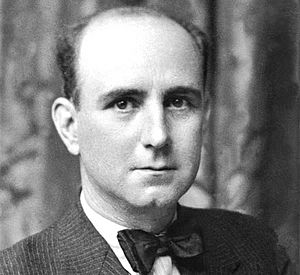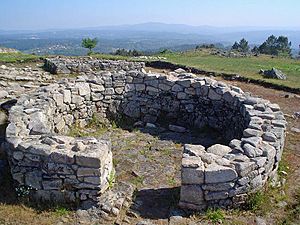Florentino López Cuevillas facts for kids
Florentino López Alonso-Cuevillas (born November 14, 1886 – died July 30, 1958) was an important Spanish anthropologist and prehistorian. This means he studied human societies and cultures, especially those from very old times. He also enjoyed writing essays and stories.
Florentino was part of a special group of thinkers and artists in Galicia called Xeración Nós. He also worked with the Seminario de Estudos Galegos and the Irmandades da Fala. These groups helped promote Galician culture and language. He even took part in politics to support Galicia, but this became difficult after the Spanish Civil War. Later, he continued his work spreading Galician culture as a member of the Royal Galician Academy.
He helped Galician literature grow, but he was most famous for his scientific work. Florentino was inspired by a book about ancient Galicia. He decided to explore and study the very old history of Galicia, which people had mostly forgotten. He focused on megalithic art (huge stone structures) and the Celtic Castro culture. His research made him the most important person in Galicia for studying prehistory. His scientific work also helped make the Galician language more widely used.
Contents
A Life of Discovery
Florentino López Alonso-Cuevillas was born on November 14, 1886, in Ourense, Spain. He was the only child of Florentino López Barbán and Vicenta Alonso-Cuevillas Álvarez. His father worked for the tax office. His mother came from a well-known family in Ourense.
Sadly, Florentino's father passed away before he was born. So, his mother moved back to Ourense to live with her family. Florentino was raised and educated by his mother's family. He received a very good education, which was rare at the time. He went to a girls' school when he was very young. Later, he attended Colegio León XIII. He also learned to play the violin.
Between 1896 and 1901, he studied at the Instituto de Orense. He had excellent teachers there. After finishing his studies, he went to the University of Santiago de Compostela. He studied pharmacology, which is about medicines. However, he never worked as a pharmacist. During college, he loved literature. He went to many literary events and talks. He graduated in 1906.
Five years later, he moved to Madrid to study social sciences. In Madrid, he met other important people like Otero Pedrayo. He went to many cultural events, including plays and operas. He worked for the government in Madrid. But he felt a bit lost there. So, he returned to Ourense. Back home, he became a tax official. He married Milagros Rodríguez, and they had three daughters.
Florentino's first writings were about politics and books. They appeared in the newspaper El Miño. He also wrote for other newspapers like La Zarpa and Faro de Vigo. In 1917, he helped start a magazine called La Centuria. His writings and talks began to show more of his interest in society and politics.
In the same year, he became involved in Galicianism. This was a movement to support the culture and language of Galicia. He joined the Irmandades da Fala. He also helped create the magazine Nós. He was involved in founding the Republican Nationalist Party of Ourense. In 1922, he published his first article about archeology in Nós. This article, Dos nosos tempos, was important for his generation of thinkers.
After the Spanish Civil War, many Galician nationalists, including Florentino, had to stop their political activities. In 1939, he continued his archeological studies. But he later developed rheumatism, which made fieldwork difficult. So, he focused on organizing and writing about Galician prehistory.
On July 7, 1941, Florentino became a full member of the Royal Galician Academy. Three years later, in 1944, he joined the Instituto de Estudios Padre Sarmiento. That same year, he wrote Prehistoria. This book became a part of the larger Historia de Galiza.
Florentino passed away on July 30, 1958, in his home in Ourense. He was buried in the Cementerio de San Francisco de Orense. A special song, Requiem a Cuevillas, was sung for him. In 1968, the sixth celebration of Galician Literature Day was dedicated to him.
Requiem a Galicia (a small part)
May the angels waiting for you
in the divine city,
crown you with the purest crowns,
receive you with the most genuine torques,
and the hand of the Eternal itself
gird you with a golden sword,
oh prince among "the good and generous ones",
Florentino Cuevillas,
ruler of the strongest and noblest battles for Galicia!
Exploring Ancient Galicia

Florentino Cuevillas did a lot of archeological work. He worked with people from the Museo da Comisión de Monumentos. His studies included a lot of information about Galicia before the Romans arrived. For example, in 1921, he published a study called A mansión de Aquis Querquernis.
In the early 1920s, he and his team started digging at the Roman camp of Aquis Querquennis. They found parts of the camp's wall and other small buildings.
Cuevillas was also a great expert on the Castro culture. This was an ancient culture that built fortified settlements called castros. His first work on this topic appeared in the magazine Nós. The first Castro site he studied was in San Cibrao de Las, Ourense. It was a large fortress, about nine hectares in size. His excavations there began in 1922 and continued until 1925. Even though the digging only lasted three years, it gave him a lot of information for his writings. He published his findings in Nós under the title A Edade de Ferro no Galiza. He also published his Catálogo dos Castros Galegos there.
In 1923, López Cuevillas joined the Seminario de Estudos Galegos. He worked closely with Fermín Bouza Brey. Together, they studied and excavated the Castro de O Neixón in 1925. There, Cuevillas found parts of a Punic aryballos. This was a type of ancient pot made in Carthage, a city in the Mediterranean. This discovery showed that people in ancient Galicia traded with merchants from the Mediterranean. His work on this site was a big part of his book Os oestrymnios, os saefes e a ofiolatría en Galicia (1929).
In 1927, he went on the first archeological journey across all of Galicia. He traveled with Fermín Bouza Brey. They studied ancient sites in Sobroso and Briteiros.
In 1929, Cuevillas worked with archeologist Lluís Pericot. They dug at the Castro de Troña. They found many ancient crafts and coins from both Celtic and Roman times. They also discovered about 30 round buildings and defensive walls.
Sometimes, Cuevillas only searched for and explored Castro sites without digging. This happened at el Outeiro do Castro, a small site in Canda.
He, along with Otero Pedrayo and Vicente Risco, believed that Castro culture ruins and dolmens (another type of ancient stone structure) were from different times. They thought the Castro culture was Celtic and not related to the Stone Age.
How Ourense Began
In 1934, Cuevillas studied how the city of Ourense might have started. He thought that roads and rivers were very important. During Roman times, a major imperial road passed through the city. Many smaller roads and natural paths like the Miño, Loña, and Barbaña-Barbadás rivers also met there.
Cuevillas believed that the first people in the area settled near As Burgas. These are natural hot springs. He thought that people from the Castro culture might have visited these hot springs before the Romans arrived. This could have led to small markets and trading places. So, when the Romans came, they found a small community already there. The Romans then helped it grow even more.
His Published Works
Prosas Galegas, 1920 - 1958
Prosas Galegas, 1920 – 1958 is a collection of 32 essays. It was published in 1962, after his death. These essays are not just about science; they also include literature. Some of them, like Como nasceu a cidade de Ourense, had been published before. But the collection showed a new side of Cuevillas as a creative writer.
People began to appreciate his clear and calm writing style. The book is divided into four parts. The first two parts celebrate Galicia's nature and traditions. They describe the countryside, cities, and customs. Some essays also comment on society, like Dos nosos tempos.
The third part has three short biographies of Galician writers. These include Curros Enríquez and Otero Pedrayo. It also has comments on Castelao's work As cruces de pedra na Galiza. All these essays were written after the Spanish Civil War.
The last part of the book focuses on his work in Galician prehistory. It includes important works like Relaciós prehistóricas entre Galicia e as Illas Británicas. These essays often explain information, like Paleopaisaxe and Mitoloxía e historia da paisaxe de Trasalba.
What Prosas galegas is Like
According to Ricardo Carballo Calero, Prosas galegas is known for its strong beliefs and beautiful writing. It shows his honesty and dreams.
Miscelánea
Many of Cuevillas's research papers were published in different magazines. These included Nós, Boletín de la Real Academia Gallega, and Cuadernos de Estudios Gallegos. Some of these works were later collected in a book called Miscelánea (1987).
See also
 In Spanish: Florentino López Cuevillas para niños
In Spanish: Florentino López Cuevillas para niños
- Castro de San Cibrao de Las
- List of castros in Galicia



